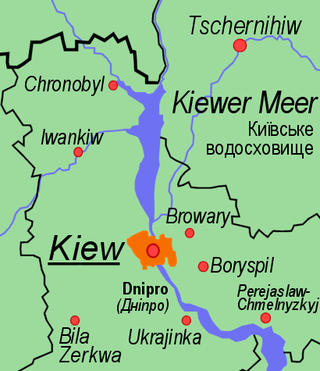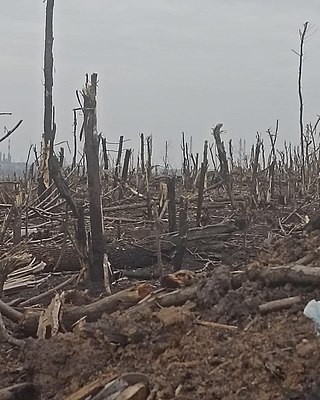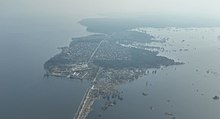
The Seversky Donets or Siverskyi Donets, usually simply called the Donets, is a river on the south of the East European Plain. It originates in the Central Russian Upland, north of Belgorod, flows south-east through Ukraine and then again through Russia to join the river Don, about 100 km (62 mi) from the Sea of Azov. The Donets is the fourth-longest river in Ukraine, and the largest in eastern Ukraine, where it is an important source of fresh water. It gives its name to the Donets Basin, known commonly as the Donbas, an important coal-mining and industrial region in Ukraine.

The Irpin or Irpen is a river in Ukraine, a right tributary of the Dnieper River. It is 162 kilometres (101 mi) long, and has a drainage basin of 3,340 square kilometres (1,290 sq mi). Irpin city is one of the urban settlements beside the river.

Bucha is a city in Ukraine's Kyiv Oblast. Administratively, it serves as the administrative center of Bucha Raion. It hosts the administration of Bucha urban hromada, one of the hromadas of Ukraine. Its population is approximately 37,321. Bucha Day is celebrated in the city between 11 and 13 September.

The Dnieper Hydroelectric Station, also known as the Dnipro Dam, is a hydroelectric power station in the city of Zaporizhzhia, Ukraine. Operated by Ukrhydroenergo, it is the fifth and largest station in the Dnieper reservoir cascade, a series of hydroelectric stations on the Dnieper river that supply power to the Donets–Kryvyi Rih industrial region. Its dam has a length of 800 metres (2,600 ft), a height of 61 metres (200 ft), and a flow rate of 38.7 metres (127 ft) per second.

The Kyiv Reservoir, locally the Kyiv Sea, is a large water reservoir located on the Dnieper River in Ukraine. Named after the city of Kyiv, which lies to the south, it covers an area of 922 square kilometres (356 sq mi) within the Kyiv Oblast. The reservoir filled in 1964–1966 after the dam for the Kyiv Hydroelectric Power Plant was built at Vyshhorod. The reservoir is mainly used for hydroelectricity generation, industrial and public consumption, and irrigation.

The Kakhovka Reservoir was a water reservoir on the Dnieper River in Ukraine. It was created in 1956 by construction of the Kakhovka Dam at Nova Kakhovka. It was one of several reservoirs in the Dnieper reservoir cascade.

The Dnieper reservoir cascade or Dnieper cascade of hydroelectric power stations is a series of dams, reservoirs and hydroelectric power stations on the Dnieper river in Ukraine. It was created to prevent uncontrolled flooding and improve water transportation infrastructure. Coordination and operation of all dams on the Dnieper is conducted by government company Ukrhydroenergo. In 1970, the Kyiv dam partially prevented flooding in comparison with the 1931 Kyiv flooding.

The North Crimean Canal, formerly known as the North Crimean Canal of the Lenin's Komsomol of Ukraine in Soviet times, is a land improvement canal for irrigation and watering of Kherson Oblast in southern Ukraine and the Crimean Peninsula. The canal has multiple branches throughout Kherson Oblast and Crimea, and is normally active from March until December.

Kyiv Hydroelectric Station is a run-of-river power plant on the Dnieper River in Vyshhorod, Kyiv Oblast, Ukraine. The 288 m (945 ft) long dam creates the Kyiv Reservoir with the purpose of hydroelectric power generation and navigability with the dam's associated lock. The first of 20 generators in the power station was commissioned in 1964, and the last in 1968. Together with the Kyiv Pumped Storage Power Plant, it creates a hydroelectricity generating complex. It is operated by the Ukrhydroenergo. Turbines for the plant were produced by the Kharkiv Factory Turboatom, and generators by the Kharkiv Factory "Elektrovazhmash".

The Kakhovka Dam was a dam on the Dnieper River in Kherson Oblast, Ukraine, completed in 1956 and destroyed in 2023, which provided water for the Kakhovka Hydroelectric Station. The primary purposes of the dam were hydroelectric power generation, irrigation, and navigation. It was the sixth and last dam in the Dnieper reservoir cascade.

Grand Meadow National Nature Park covers historic steppe terrain in southeast Ukraine. It is on the south bank of the Dnieper River's Kakhovka Reservoir, which was created by the Dnieper Hydroelectric Station. The meadows and reed beds on the shore support one of the largest transmigration spots for birds in Eastern Europe. The park is in the administrative district of Vasylivka Raion in Zaporizhzhia Oblast.

The northern Ukraine campaign was a theater of operation in the Russian invasion of Ukraine. It involved attacks by Russia across the Russo-Ukrainian and Belarusian–Ukrainian borders, beginning on 24 February 2022, for control of Kyiv, the capital of Ukraine, and the surrounding areas of Kyiv Oblast and northern regions Zhytomyr Oblast, Sumy Oblast, and Chernihiv Oblast. Kyiv is the seat of the Ukrainian government and the headquarters of the Armed Forces of Ukraine.

The battle of Irpin was part of the Kyiv offensive in the Russian invasion of Ukraine for control of the city of Irpin. The combatants were elements of the Russian Armed Forces and Ukrainian Ground Forces. The battle lasted from 27 February 2022 to 28 March 2022 and ended with Ukrainian forces recapturing the city.
Hydraulic warfare (HW) is the use of water from reservoirs, rivers, canals, and other water features to impede the operations of an opposing force. This may involve breaching dams and rerouting watercourses. It can be used to impede the advance of an attacker or to reduce the resources and tactical options for defenders. The technique has been used to create "devastating floods, isolate troops, cut off supply lines, hinder river crossings, and disrupt military timetables".

The Russian invasion of Ukraine has led to ongoing widespread and possibly serious and long-term environmental damage. The Ukrainian government, journalists and international observers describe the damage as ecocide.
Demydiv is a village in Vyshhorod Raion, Kyiv Oblast, Ukraine. It belongs to Dymer settlement hromada, one of the hromadas of Ukraine. Demydiv lies on the western bank of the Irpin River, north of Kyiv. It is one of the oldest villages in Ukraine, founded in 1026.

Russian occupiers carried out a series of artillery fire and air raids in the city of Kryvyi Rih during the Russian invasion of Ukraine.

The battle of Moshchun was a series of military engagements for control of the village of Moshchun and its surroundings during the initial phase of the Russian invasion of Ukraine. The battle lasted from 5 March to 21 March 2022, and has been described as "one of the fiercest and most important battles during the defense of Kyiv."

The Kakhovka Dam was breached in the early hours of 6 June 2023, causing extensive flooding along the lower Dnieper river, also called the Dnipro, in Kherson Oblast. The dam was under the control of the Russian military, which had seized it in the early days of the Russian invasion of Ukraine. Many experts have concluded that Russian forces likely blew up a segment of the dam to hinder the planned Ukrainian counter-offensive. Russian authorities have denied the accusation.
Bridges have been a strategic and tactical aspect of the Russo-Ukrainian War, particularly since the 2022 Russian invasion of Ukraine. As there are more than 23,000 rivers and over 28,000 bridges in Ukraine, several important events, including battles, blocked advances, political disputes, and the successes and failures of army units, have centered around the country’s bridges. The UK Ministry of Defense has said, "River crossing operations are likely to be amongst the most important determining factors in the course of the war".


















